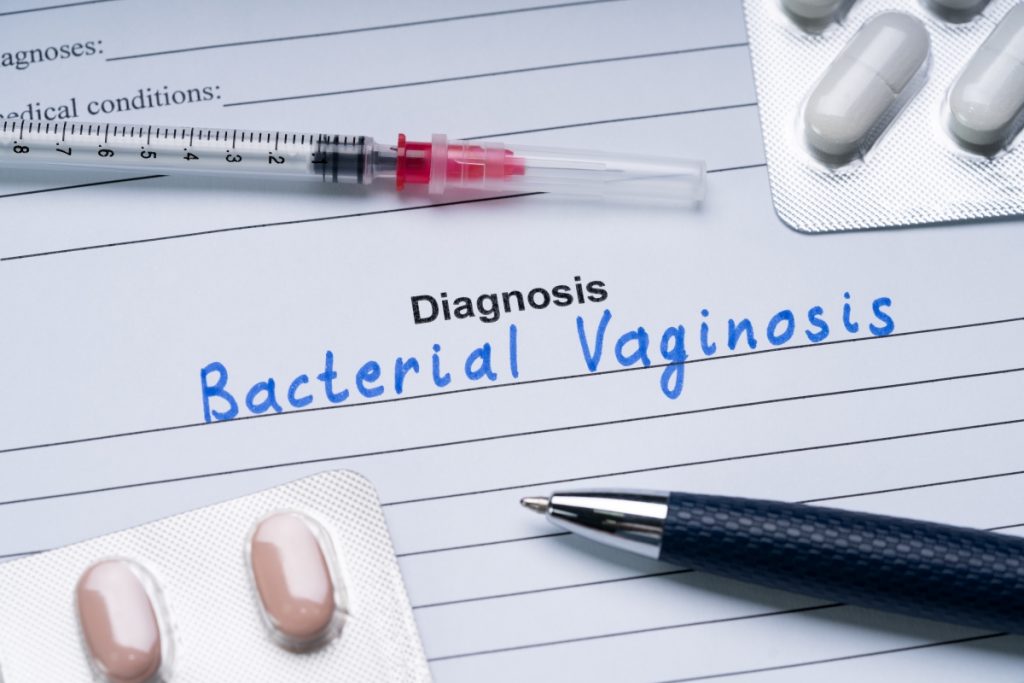
Bacterial vaginosis (BV) is a common bacterial infection in the vagina when different kinds of healthy bacteria get out of balance and grow too much. Bacterial vaginosis is often caused by Gardnerella vaginalis, the most common type of bacteria in the vagina. As a result of the overgrowth of certain bacteria, vaginal discharge is common.
Having multiple sex partners, vaginal douching, and being pregnant increases the chance of developing BV. While BV increases the risk of developing a sexually transmitted disease (STI), the infection itself is not considered an STI.
BV is most common in women between the ages of 15 to 44 years and is rare for women to develop if she has never been sexually active.
Symptoms
Most women experience hardly any to no symptoms at all. The most common symptom of BV is vaginal discharge and odor. The discharge may be gray in color, watery and thin, and has been described as smelling fishy.
Less commonly, women may have a burning sensation during urination or itching around the vagina.
The infection shows no symptoms at all for 50 to 75 percent of women, but BV can cause serious complications to arise if left untreated. If you are experiencing any of these symptoms make an appointment with your doctor.
Complications of BV
Having intercourse with someone who has BV, as well as having multiple sex partners or a new one, can put you at risk for the infection. Untreated vaginosis can lead to:
- Pelvic inflammatory disease (PID) – An inflammation of the female reproductive system, including the uterus, fallopian tubes, and the ovaries.
- Greater risk of sexually transmitted infections – HIV, gonorrhea, and chlamydia.
- Increased risk of postsurgical infection – After surgeries affecting the reproductive system, such as a hysterectomy.
The Centers for Disease Control and Prevention (CDC) estimates that 1 million pregnant women are diagnosed with BV each year. Pregnant women are at an increased risk of BV because of hormone changes that happen during pregnancy. If you have BV while pregnant, you are at an increased risk of:
- Early or preterm delivery
- Loss of pregnancy
- The amniotic sac breaking open too early
- Postpartum endometritis – An irritation or inflammation of the lining of the uterus after delivery
- Tubal factor infertility – Damage to the fallopian tubes, which connect the ovaries to the uterus
- Chorioamnionitis – An inflammation of the membranes surrounding the fetus, known as the chorion and the amnion. It also increases the chance of early delivery and the baby has a higher risk of cerebral palsy.
- In-vitro fertilization (IVF) may be less likely to succeed.
Causes
Many bacteria reside in the vagina. BV is caused by an imbalance of the naturally occurring “good” bacteria (lactobacilli) and “bad” bacteria (anaerobes). Usually, lactobacilli bacteria outnumber anaerobes bacteria but if there are too many anaerobic bacteria, they upset the natural balance in your vagina and cause bacterial vaginosis.
Risk Factors
Any woman is a risk for BV, even if they have never had sex. You may be more at risk for BV if you:
- Douche or use water or medicated solution to clean the vagina
- Have a new sex partner
- Have multiple sex partners
- Use perfumed bubble baths, vaginal deodorants and strong scented soaps
- Smoke
- Wash underwear with strongly scented detergents.
BV cannot be caught from toilet seats, bedding, swimming pools, or by touching objects.
Diagnosing BV
The diagnosis of BV requires a vaginal exam by a doctor or from a description of the symptoms. An examination to diagnose BV is like a regular gynecological checkup, examining the vagina for signs of BV which include vaginal discharge that has a white or gray color.
The doctor may order some diagnostic tests if the patient is sexually active, due to the chance an STI (sexually transmitted infection) is present.
The pH balance of the vagina may also be measured to assess acidity levels.
Prevention Tips
While there is no certain way to prevent BV, some tips can help. These include:
- Avoid over-washing and using vaginal deodorants or scented wash
- Change tampons or pads frequently
- Ensure to wipe front to back after going to the toilet
- Practice safe sex
- Do not douche.
Recurring Symptoms
It is common for BV symptoms to come back within 3 to 12 months of treatment. Around 30 percent of women will have a recurrence within 3 months, and 50 percent will have a recurrence within 6 months.
If the original treatment was oral medication, vaginal treatment might work better the second time. On the other hand, if the first treatment was vaginal, the follow-up treatment should be by mouth.
The doctor may prescribe a vaginal metronidazole gel to use twice a week for three to six months if more than three episodes occur within 12 months.
Treatment
BV can often clear up without treatment, but women experiencing symptoms should seek treatment to avoid future complications.
It is important to see your doctor if there is an abnormal vaginal discharge because a doctor can rule out other infections, such as gonorrhea or trichomoniasis (or “trich”). Untreated BV can also lead to complications, especially during pregnancy.
Male partners usually do not require treatment, but they can spread BV between female sex partners.
Antibiotic Medication
If BV does not clear up on its own, antibiotics are effective in up to 90 percent of cases. Metronidazole and Tinidazole are two commonly prescribed oral medications prescribed to treat BV.
Even though symptoms should clear up within two or three days, it is important to finish out the full five or seven days course of antibiotics. Your doctor might also prescribe Clindamycin, a suppository cream.
While taking antibiotics, avoid having vaginal intercourse or inserting anything into the vagina that could introduce bacteria, including:
- Tampons
- Menstrual cups
- Sex toys.
Make an Appointment
If you have any concerns, please call us at 770.720.7733 or schedule an appointment at either our Woodstock or Canton location.


